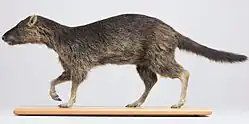Amphirhagatherium
| Amphirhagatherium | |
|---|---|

| |
| Model of A. weigelti | |
| Scientific classification | |
| Kingdom: | Animalia |
| Phylum: | Chordata |
| Class: | Mammalia |
| Order: | Artiodactyla |
| Family: | †Choeropotamidae |
| Genus: | † Depéret, 1908 |
| Type species | |
| †Amphirhagatherium fronstettense Depéret, 1908
| |
| Species | |
| |
| Synonyms | |
| |
Amphirhagatherium is an extinct genus of artiodactyl that lived in Northern Europe during the late Eocene to Early Oligocene.[1]
The dentition of Amphirhagatherium suggests that the genus had a mixed diet of leaves and fruits likely eaten at ground level. Caniniform anterior teeth suggest that there may have been a small carnivorous dietary component, or that they were used for intraspecific combat.[1]
Distribution
- Eocene
- Creechbarrow Limestone, Upper Headon Beds and Bembridge Marls Formations, England
- Frohnstetten, Germany
- Geiseltal, Germany
- Rocourt-Saint-Martin and Chéry-Chartreuve, France
- Oligocene
- Bembridge Marls, England
References
- ^ a b Hooker, J. J. (2001). "A New Species of Amphirhagatherium (Choeropotamidae, Artiodactyla, Mammalia) from the Late Eocene Headon Hill Formation of Southern England and Phylogeny of Endemic European 'anthracotherioids'". Palaeontology. 44 (5): 827–853. Bibcode:2001Palgy..44..827H. doi:10.1111/1475-4983.00203.